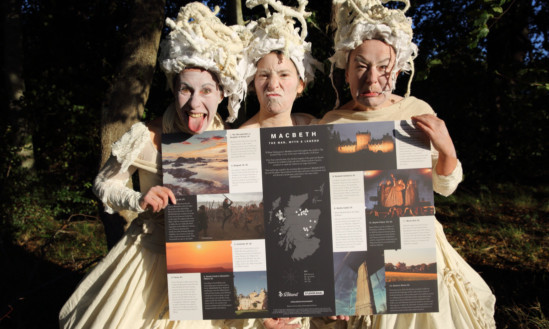If trees could talk, then the gnarled and ancient Birnam Oak which rests wearily on crutches on the south bank of the River Tay at Birnam would surely have some amazing tales to tell.
Whilst not nearly as old as the legendary 5000-year-old Fortingall Yew, further north in Highland Perthshire, the Birnam Oak, complete with its three metres of hollow trunk, is thought to be one of the sole surviving trees of the great Royal Forest that once straddled the banks and hillsides of the River Tay.
History records that the Royal Forest, which includes Birnam Hill, was gifted in 1160 by Malcolm, the Maiden, to Duncan, Earl of Fife, on his marriage with Princess Ada, the King’s niece. This Duncan was a descendant of that MacDuff who accompanied Malcolm Canmohr on his march to oust the real Macbeth in 1054. Macbeth was finally defeated and killed in a battle at Lumphanan in Aberdeenshire on August 15, 1057.
But it was Shakespeare’s Macbeth, a blend of fact and fiction written over 400 years ago, which gave rise to the notoriety of the famous Birnam Wood, alongside Perthshire’s Dunsinane Hill, near the village of Collace.
The places were immortalised by Shakespeare when he wrote:””Macbeth shall never vanquished be, until Great Birnam wood to high Dunsinane hill Shall come against him.”
The prophecy of Shakespeare’s three witches did come true, with the branches of trees from great Birnam Wood, camouflaging the advancing army against Macbeth.
The Bard also gave his lead character the title of ‘Thane of Glamis’, which lies in Angus whilst Scone Moot Hill is where Macbeth was crowned.
It is believed that Shakespeare got inspiration for this section of `The Scottish Play` during a visit to Perth, Birnam and Aberdeen in 1599 as one of a troupe of comedians.
The visit was arranged after King James IV sent a request for entertainers to Elizabeth I.
Others have disputed whether Shakespeare ever made the journey north.
Both the Birnam Oak and another survivor from the forest, the 300-year-old Birnam Sycamore, appear in the list of the 100 Scottish Heritage Trees, and are already a draw for visitors.
The Birnam Oak is among the six finalists in the 2015 Scottish Tree of the Year contest, organised by Woodland Trust Scotland.
But Visit Scotland are predicting that the area could be about to get another tourism boost thanks to the release of the critically acclaimed new version of Macbeth.
The premiere takes place on Sunday at Edinburgh’s Festival Theatre
With Hollywood A-listers Michael Fassbender and Marion Cotillard leading the parade on the red carpet, with support from the likes of Paddy Considine and David Thewliss.
The movie was first shown at the Cannes Film Festival in May has won widespread acclaim from critics. It is tipped to be a hit at the box office after a general release on October 2.
Australian director Justin Kurzel has focused on the violence and brutality of the infamously dark tale.
The film is already being tipped for Oscar success in 2016, with Cotillard (who bagged an Academy Award for La Vie En Rose) and Fassbender (nominated for 12 Years A Slave) both likely to be in the running again.
Meanwhile, tourism bosses at VisitScotland – who are never slow to spot a canny marketing opportunity – are already rubbing their hands with glee at the anticipated boost in visitor numbers.
The dramatic scenery of the Isle of Skye features prominently in the film, although other locations linked to Macbeth – such as Birnam Wood and Cawdor Castle in Nairn – will also hope to benefit.
Now, VisitScotland have launched a new guide encouraging visitors to follow in the footsteps of Macbeth.
It highlights more than 20 Macbeth locations throughout Scotland with an online guide: Macbeth The Man, Myth & Legend.
To celebrate the launch last week, three ‘Weird Sisters’ gathered in the grounds of Brodie Castle, Forres, a mere stone’s throw from Macbeth’s Hillock which, according to local folklore, is the ‘blasted heath’ where the tragic king and his friend Banquo meet the foreboding trio in William Shakespeare’s play.
The guide focuses on places associated with the real Macbeth, who reigned from 1040 to 1057, the lead character from Shakespeare’s tragedy, as well as the Skye filming locations used as stunning backdrops in director Justin Kurzel’s epic.
Mike Cantlay, Chairman of VisitScotland, said: “This new guide gives visitors to Scotland a fascinating insight into one of our most enduring figures. Featuring places of historical significance, theatrical intrigue and stunning beauty, our new web pages will encourage more people to discover the places associated with Macbeth the man, the myth and the legend. The map includes the amazing locations used in the new movie, with 40% of visitors to the UK inspired to come here after seeing a location on film or on television.”
Culture Secretary Fiona Hyslop said: “The much-anticipated movie will showcase our stunning scenery and our rich heritage to audiences around the world.”
